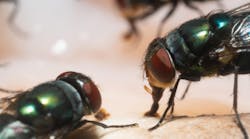Sometimes drop-in guests can be more annoying than the ones you know are coming. That’s as true for food plants as it is for vacation homes.
Pest-control programs are often aimed at eliminating obvious pests, like rats and cockroaches, that pose a constant threat, seasonally if not year-around. But certain kinds of bugs and other critters can invade facilities seemingly at random, at any time. These can be, in some ways, harder to deal with than the species that are constant threats.
These kinds of pests are sometimes called “occasional” or “accidental” invaders. They comprise a wide variety of species, including ground beetles, ladybugs, crickets, box elderbugs, stinkbugs, mites, centipedes, millipedes, earwigs, springtails, sowbugs, pillbugs, clover mites and earwigs. What they all have in common is that, even from their own perspective, they have no business in a food plant; there’s no reason for them to be there and, in most cases, little or nothing for them to survive on.
“Accidental invaders are insects and other arthropods that wander into structures without any specific benefit from a survival standpoint,” says Patricia Hottel, technical director at McCloud Services. They get in, in other words, entirely by chance. Weak fliers might literally get pushed in through an open door or other entry point by a gust of wind; others might be attracted to indoor water during a dry spell, or the opposite – they seek indoor dryness during rain.
“With some invaders it is not an attraction, but rather overwhelming numbers in the area and the plant just being in the way of the invaders,” says Myron Baumann, owner of P&M Pest Consulting.
However they get in, for whatever reason, their unpredictability is what makes them a special source of concern, because it makes them hard or impossible to plan for.
“Occasional invaders are problematic and can be tough to prepare for,” says Godfrey Nalyanya, entomologist and technical services manager for Rentokil. “You don’t expect them and suddenly you see a centipede or ground beetle in your facility, and you have to deal with it.”
Unlike more common pests like rats, occasional invader species do not thrive or even reproduce indoors, mostly because plants usually don’t have sources of standing water to sustain them. (If they do, that almost always indicates a leak or other problem.) Most of them don’t find food indoors either, although there are exceptions.
“Long humid days create more microscopic molds to grow inside processing areas and especially in powder plants,” Baumann says. “This microscopic mold is food for several pests, including springtails, Psocids and fungus beetles. The populations of these pest will literally explode in a short period of time under the right conditions.”
Most occasional invaders are not as actively harmful as pests like rats, which can devour product, bite or bring disease. Still, the presence of any bug or other critter inside a food plant is unwelcome, because even the ones that are small and don’t bite can get into the food or packaging.
Learn how to protect your facility from stored product insects, pests that can compromise products without anyone realizing they’re there. Listen to our July 2020 Pest Control Webinar On Demand
In the puckish words of Jerry Heath, product manager and staff entomologist for Industrial Fumigant Co. (IFC): “There is a huge opportunity for some insect to be caught up in a shrink wrapper and be preserved for observation farther down the distribution stream.”
Keeping them out
Because accidental invaders are so unpredictable, the best way to deal with them is to keep them out in the first place. That usually means keeping things that might attract them away from the building’s exterior.
Mulch is a big potential problem; it’s a perfect harborage for some insects. If it must be used, it should be kept away from a building’s immediate perimeter, and it should be changed out; new mulch should not be thrown on top of old.
Vegetation and landscaping around a plant should be chosen carefully to avoid attracting occasional pests (as well as more constant ones like birds). Hottel suggests not letting a lawn grow more than two feet closer to the building’s foundation, perhaps with a rock barrier to prevent encroachment. Tree limbs should not be allowed to touch the structure, and flowering or fruit trees should be avoided, since they attract aphids and other insects that secrete honeydew, which in turn can attract accidental invaders.
Lighting is another concern. Whenever possible, lights should be mounted on poles or other external fixtures, not attached to the building. Mercury lighting should be avoided; if LEDs are used, they should be on the spectrum least attractive to insects.
Trash is another potential “attractive nuisance” for insects, which should be obvious but is often neglected, Heath says. “A huge deficiency across the industry is waste management and the accumulation of aromatic organic residues on waste-handling equipment, dumpsters, compactors, etc., which attracts flies and other pests that will invariably invade.”
Another prevention method should be standard: making sure the plant has no unintended ingress points. That means door sweeps are installed and in good order, no ripped window screens, no crevices around windows and doors, and no other breaches. Other potential problem areas include gaps in corrugated metal fabricated buildings and in the juncture between the foundation and an exterior wall.
Gaps in doors and walls are a common entry point for accidental invaders.
Vermin vigilance
Because accidental invaders can strike at any time, and are often tiny, it sometimes takes a while to detect them. Two kinds of vigilance can help. The first is to train floor workers to report the presence of any kind of insect or other pest whenever they spot one.
“Don’t forget to include your employees in your preparation,” says Orkin’s Black. “They are often the first line of defense against pests, so encourage them to look out for pests and report any sightings immediately.”
The second is to set up sticky-surface traps, usually with ultraviolet light that attracts insects, and have an expert analyze the results – that is, identify the insects that get stuck. (Contrary to what pest control providers say is a surprisingly common belief, such traps are not control measures; they can’t, by themselves, reduce an insect population. All they do is give a sample of what’s in the plant.)
Once they do get in, options are somewhat limited. Shane McCoy, director of quality and technical training for Wil-Kil Pest Control, says pesticides are a last resort, and when they are used, they’re applied from the outside, since growth of the population inside the plant is not usually a problem for accidental invaders.
Black says that with these kinds of small species local experience helps. “Treatment for these types of pests is often significantly different than for structure-infesting pests, so additional treatments may be required,” she says. “These ‘minor’ pests are often less studied by pesticide manufacturers and university researchers, so dealing with a pest management company that has experience in your area is helpful in providing insight into what has worked and what has not.”
What’s in the contract?
Accidental invaders can pose another problem: getting the pest management company to deal with them. Contracts often spell out the exact species that the pest contractor will protect against. Many kinds of species can become accidental invaders, and most of them aren’t specified in standard contracts.
“Including occasional invaders in a scope of service for a food plant is a little like betting the over or under on a sports game,” Baumann says.
This is because from the contractor’s point of view, accidental invaders pose several problems. They may show up one year but not the next; and when they do, the products and equipment needed to get rid of them may be different from what is included in general pest management. The best way a food processor can make sure of coverage is to keep a record of pest invasions, which sets clear expectations for the contractor.
“If you have historical pest activity data, your pest management provider will be able to develop a customized plan that can be adjusted based on seasonal and occasional pest threats,” Black says. “An experienced provider will also be able to inform you about which pests can pose risks to your business based on your location and facility.”
Occasional invaders can be covered in a pest management contract, but this has to be addressed explicitly, which should be insisted on by any processor worried about them.
“The pest management firm may or may not include all occasional invaders or accidental invaders in their standard contract,” Hottel says. “This should be discussed as part of initial and ongoing risk assessments and services, and added to the contract as needed.”
McCoy of Wil-Kil says a phrase like “occasional invaders” or “crawling insects” in the contract should be sufficient. “If they just say ‘occasional invaders,' that would cover them for the 10 or 15 species instead of having to spell each one of them out.” He adds, however, that contracts often exclude venomous stinging or biting species (industry jargon is “species of medical importance”), because those need special equipment and trained personnel to extract.
The glorious variety of nature isn’t so glorious when it comes to the proliferation of things that can cause problems inside a food plant. But the right preparation and foresight can go a long way toward making sure they never become a serious problem.


